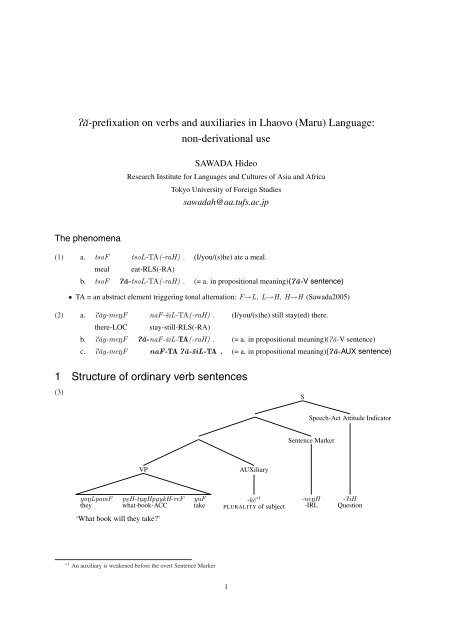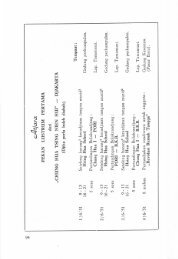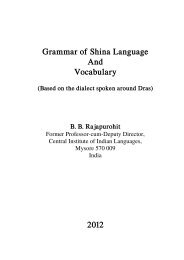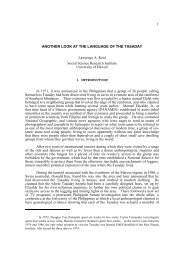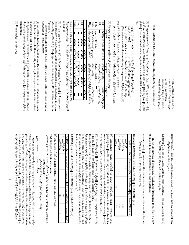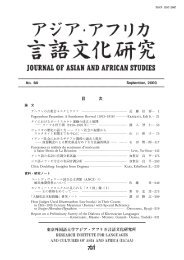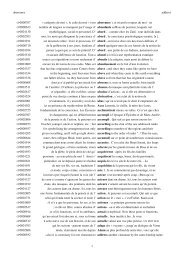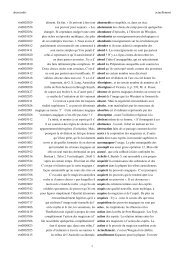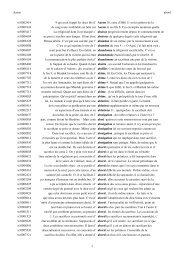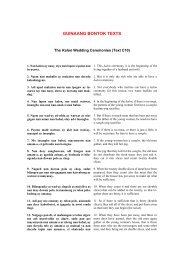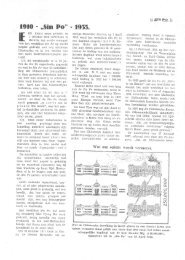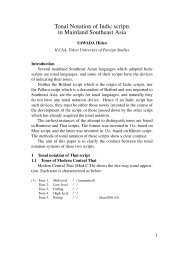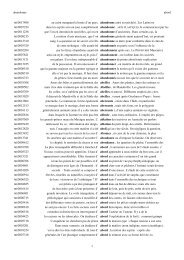PËa-prefixation on verbs and auxiliaries in Lhaovo (Maru) Language ...
PËa-prefixation on verbs and auxiliaries in Lhaovo (Maru) Language ...
PËa-prefixation on verbs and auxiliaries in Lhaovo (Maru) Language ...
Create successful ePaper yourself
Turn your PDF publications into a flip-book with our unique Google optimized e-Paper software.
Pă-<str<strong>on</strong>g>prefixati<strong>on</strong></str<strong>on</strong>g> <strong>on</strong> <strong>verbs</strong> <strong>and</strong> <strong>auxiliaries</strong> <strong>in</strong> <strong>Lhaovo</strong> (<strong>Maru</strong>) <strong>Language</strong>:<br />
n<strong>on</strong>-derivati<strong>on</strong>al use<br />
SAWADA Hideo<br />
Research Institute for <strong>Language</strong>s <strong>and</strong> Cultures of Asia <strong>and</strong> Africa<br />
Tokyo University of Foreign Studies<br />
sawadah@aa.tufs.ac.jp<br />
The phenomena<br />
(1) a. tsoF tsoL-TA(-raH) . (I/you/(s)he) ate a meal.<br />
meal eat-RLS(-RA)<br />
b. tsoF Pă-tsoL-TA(-raH) . (= a. <strong>in</strong> propositi<strong>on</strong>al mean<strong>in</strong>g)(Pă-V sentence)<br />
• TA = an abstract element trigger<strong>in</strong>g t<strong>on</strong>al alternati<strong>on</strong>: F→L, L→H, H→H (Sawada2005)<br />
(2) a. Păy-meNF naF-šiL-TA(-raH) . (I/you/(s)he) still stay(ed) there.<br />
there-LOC stay-still-RLS(-RA)<br />
b. Păy-meNF Pă-naF-šiL-TA(-raH) . (= a. <strong>in</strong> propositi<strong>on</strong>al mean<strong>in</strong>g)(Pă-V sentence)<br />
c. Păy-meNF naF-TA Pă-šiL-TA . (= a. <strong>in</strong> propositi<strong>on</strong>al mean<strong>in</strong>g)(Pă-AUX sentence)<br />
1 Structure of ord<strong>in</strong>ary verb sentences<br />
(3)<br />
S<br />
Speech-Act Attitude Indicator<br />
Sentence Marker<br />
VP<br />
AUXiliary<br />
yoNLpamF pēH-tūNHpāūkH-reF yuF<br />
they what-book-ACC take<br />
-kĕ * 1<br />
PLURALITY of subject<br />
-neNH<br />
-IRL<br />
-PiH<br />
Questi<strong>on</strong><br />
‘What book will they take’<br />
*1 An auxiliary is weakened before the overt Sentence Marker<br />
1
(4) Paradigm of verb sentences:<br />
tāH ‘to speak’ naF ‘to stay’ tsoL‘to eat’<br />
Informative: pos. tāH (-raH) naL (-raH) tsoH (-raH) ‘... V(s)/Ved’<br />
ReaLiS neg. mă-tāH mă-naF mă-tsoL ‘... do(es) not V/did not V’<br />
Informative: pos. tāH -neNH naF -neNH tsoL -neNH ‘... will V’<br />
IrReaLis neg. mă-tāH -neNH mă-naF -neNH mă-tsoL -neNH ‘... will not V’<br />
IMPerative: pos. tāH (-HaPF) naF (-HaPF) tsoL (-HaPF) ‘V!’<br />
neg. tă-tāH tă-naF tă-tsoL ‘D<strong>on</strong>’t V’<br />
HORTative: *2 pos. tāH -laNL naF -laNL tsoL -laNL ‘Let’s V’<br />
OPTative: pos. tāH -šoNL naF -šoNL tsoL -šoNL ‘May ... V’<br />
neg. mă-tāH -šoNL mă-naF -šoNL mă-tsoL -šoNL ‘May not ... V’<br />
• Assume -φ as the marker of negative Realis Informative sentence. * 3<br />
• Assume -φ also as the marker of Imperative sentences. * 4<br />
• Assume TA, an abstract element trigger<strong>in</strong>g t<strong>on</strong>al alternati<strong>on</strong>: F→L, L→H, H→H * 5<br />
(5) Members of AUX class <strong>and</strong> their relative order<br />
-šiL‘still’ -vaH REALIZATION (<strong>on</strong>ly <strong>in</strong> -kōH PLURALITY OF SUBJECT (<strong>in</strong> Realis Informative)<br />
-loL‘anymore’ Realis Informative) -kePF PLURALITY OF SUBJECT (<strong>in</strong> others)<br />
(6) ‘still’ ‘anymore’ PLURAL ‘still’+PLURAL<br />
negative RLS mă-naF-šiL mă-naF-loL mă-naF-kōH mă-naF-šă-kōH * 6<br />
positive RLS naF-šiH(-raH) naF-loH(-raH) naF-kōH(-raH) naF-šă-kōH(-raH)<br />
(7) Paradigm of verb sentences (generalized): * 7<br />
positive<br />
negative<br />
(Informative:) RLS V(-AUX) -TA (-raH) mă-V(-AUX) -φ<br />
IRL V(-AUX) -neNH mă-V(-AUX) -neNH<br />
IMP V(-AUX) -φ (-HaPF) tă-V(-AUX) -φ<br />
HORT V(-AUX) -laNL —<br />
OPT V(-AUX) -šoNL mă-V(-AUX) -šoNL<br />
*2 There is no negative hortative sentence.<br />
*3 mă- does not always mark negative sentences.<br />
*4 -HaPF is dispensable, though occurs very often.<br />
*5 -raH also is dispensable, though it occurs very often.<br />
*6 In a str<strong>in</strong>g of AUXs, all but the last <strong>on</strong>e are weakened<br />
*7 cf. Paradigm of verb sentences of modern literary Burmese positive negative<br />
Informative Realis V-sF¸ /V-t”iL/<br />
m-V- /mă-V-/<br />
Irrealis<br />
V-mF¸ /V-miL/<br />
Optative V- /V-/ m-V-nHN¸ä /mă-V-hniðC/<br />
2
2 Structural analysis of Pă-V/Pă-AUX sentences<br />
2.1 Correlati<strong>on</strong> with sentence types (speech-act type <strong>and</strong> polarity)<br />
(8) Sentence types which take Pă-V:<br />
positive<br />
negative<br />
RLS Pă-naF -TA(-raH) *mă-Pă-naF -φ / *Pă-mă-naF -φ<br />
IRL Pă-naF -neNH *mă-Pă-naF -neNH / *Pă-mă-naF -neNH<br />
IMP Pă-naF -φ(-HaPF) *tă-Pă-naF -φ / *Pă-tă-naF -φ<br />
HORT Pă-naF -laNL —<br />
OPT Pă-naF -šoNL *mă-Pă-naF -šoNL / *Pă-mă-naF -šoNL<br />
(9) Sentence types which take Pă-V (with AUX(s)):<br />
positive<br />
negative<br />
RLS Pă-naF -šiL-TA(-raH) *mă-Pă-naF -šiL-φ / *Pă-mă-naF -šiL-φ<br />
IRL Pă-naF -šă-neNH *mă-Pă-naF -šă-neNH / *Pă-mă-naF -šă-neNH<br />
IMP Pă-naF -šiL-φ(-HaPF) *tă-Pă-naF -šiL-φ / *Pă-tă-naF -šiL-φ<br />
HORT Pă-naF -šă-laNL —<br />
OPT Pă-naF -šă-šoNL *mă-Pă-naF -šă-šoNL / *Pă-mă-naF -šă-šoNL<br />
• Negative sentences cannot take Pă-V with or without AUX.<br />
(10) Sentence types which take Pă-AUX:<br />
positive<br />
negative<br />
RLS naF-TA Pă-šiL-TA mă-naF-TA Pă-šiL-TA<br />
IRL *naF-TA Pă-šă-neNH *mă-naF-TA Pă-šă-neNH<br />
IMP *naF-TA Pă-šiL-φ(-HaPF) *tă-naF-TA Pă-šiL-φ<br />
HORT *naF-TA Pă-šă-laNL —<br />
OPT *naF-TA Pă-šă-šoNL *mă-naF-TA Pă-šă-šoNL<br />
• Only Realis Informative sentences have Pă-AUX counterparts.<br />
2.2 With a verb c<strong>on</strong>catenati<strong>on</strong>/an AUX str<strong>in</strong>g<br />
(11) Pă-V with a verb c<strong>on</strong>catenati<strong>on</strong><br />
a. mă-lāūNH -TA -phoNF -TA -yapF -φ ‘It is not the case that (we) always run <strong>and</strong> sleep.’<br />
not- always-& -run -& -sleep -NEG<br />
b. Pă- lāūNH -TA -phoNF -TA -yapF -TA ‘It is that (we) always run <strong>and</strong> sleep.’<br />
c. * lāūNH -TA-Pă-phoNF -TA -yapF -TA<br />
d. * lāūNH -TA -phoNF -TA-Pă-yapF -TA<br />
• A verb c<strong>on</strong>catenati<strong>on</strong> can be analyzed as a coord<strong>in</strong>ati<strong>on</strong> of <strong>verbs</strong>, <strong>and</strong> TA functi<strong>on</strong>s as the coord<strong>in</strong>ator.<br />
• Pă- can be attached <strong>on</strong>ly to a whole verb c<strong>on</strong>catenati<strong>on</strong>, same as negative prefix mă-.<br />
3
(12) Pă-AUX with an AUX str<strong>in</strong>g<br />
a. naF -TA Pă-šă - vă - kōH -TA ‘It is that (they) still stay’<br />
stay- - still - REALIZATION - PLURAL-RLS<br />
b. *naF -TA šiL Pă-vă - kōH -TA<br />
c. *naF -TA šă - vaH Pă-kōH -TA<br />
• Pă- can be attached <strong>on</strong>ly to a whole AUX str<strong>in</strong>g.<br />
That is, Pă- cannot ‘break’ neither a verb c<strong>on</strong>catenati<strong>on</strong> nor an AUX str<strong>in</strong>g.<br />
2.3 The structure of Pă-AUX sentence<br />
2.3.1 TA immediately preced<strong>in</strong>g Pă-<br />
It occurs whether the verb has negative prefix or not.<br />
(13) Functi<strong>on</strong>al classificati<strong>on</strong> of TAs<br />
Part of <strong>in</strong>strumental case marker-TAyaNF * 8<br />
Marker of positive Realis Informative sentence (7): TA <strong>in</strong> questi<strong>on</strong> also occurs <strong>in</strong> negative .<br />
Coord<strong>in</strong>ator of <strong>verbs</strong> (11)<br />
• Marker of attributive element<br />
(14) positive negative<br />
RLS naL(-raH) pyuF mă-naL(-raH) pyuF<br />
‘a pers<strong>on</strong> who stays/stayed’ ‘a pers<strong>on</strong> who does/did not stay’<br />
IRL naF -neNH pyuF mă-naF -neNH pyuF<br />
‘a pers<strong>on</strong> who will stay’ ‘a pers<strong>on</strong> who will not stay’<br />
(15) Paradigm of attributive clause (generalized):<br />
positive<br />
negative<br />
RLS V(-AUX) -TA -TA(-raH) mă-V(-AUX) -φ -TA(-raH)<br />
IRL V(-AUX) -neNH -TA mă-V(-AUX) -neNH -TA<br />
• An attributive clause can be analyzed as an Informative sentence with an attributive marker TA<br />
• The effects of TAs cannot be accumulated.<br />
Support<strong>in</strong>g evidences:<br />
(16) a. chĕ-ruL kātH-TA-raH * 9<br />
(I) did like this.<br />
this-like do-RLS-RA<br />
b. chĕ-ruL-TA<br />
this-like-ATTR<br />
mukFsukHpāūkH<br />
book<br />
such a book<br />
*8 The notati<strong>on</strong> shows that yaNF always triggers t<strong>on</strong>al alternati<strong>on</strong> of the immediately preced<strong>in</strong>g syllable.<br />
4
(17) a. PăfoPH luFluF-tsaL NatF-TA A leaf is wide <strong>and</strong> th<strong>in</strong><br />
leaf wide&th<strong>in</strong>RDPL-<strong>on</strong>ly CPL-RLS<br />
b. PăfoPH luFluF-tsaL-TA ruF<br />
leaf wide&th<strong>in</strong>RDPL-<strong>on</strong>ly-ATTR th<strong>in</strong>g<br />
a wide <strong>and</strong> th<strong>in</strong> leaf (lit. a leaf, <strong>and</strong> what is wide <strong>and</strong> th<strong>in</strong>)<br />
(18) Pă- as a nom<strong>in</strong>alizer prefix<br />
PăGiL<br />
big <strong>on</strong>e<br />
< GiL ,<br />
to be big<br />
PălauNF<br />
heat<br />
< lauNF ,<br />
to be hot<br />
PămyōNF<br />
height<br />
< myōNF<br />
to be high<br />
Păp<strong>in</strong>F<br />
end<br />
< p<strong>in</strong>F<br />
to end<br />
PăpuNH<br />
hole<br />
< puNH ,<br />
to hole<br />
PăNø¯<br />
H<br />
lid<br />
< Nø¯<br />
H ,<br />
to cover<br />
PătaNL<br />
bunch<br />
< taNL ,<br />
to bunch<br />
PăsoL<br />
mark<br />
< soL<br />
to mark<br />
Pă-AUX sentences have quasi-attributive structure: a nom<strong>in</strong>alized AUX with an attributive clause<br />
2.3.2 Pă-TA after AUX (clearly detected <strong>on</strong>ly <strong>in</strong> case AUX is -šiL‘still’/-loL‘anymore’. See (6))<br />
Take it a special case of the marker of positive Realis Informative sentence.<br />
(19) a. Păy-meNF naF -TA-TA Pă-šiL-TA . ‘It is that (he) is/was still there.’<br />
there-LOC stay-RLS-ATTR PRF-still-RLS (reanalysis of (2c))<br />
b. Păy-meNF mă-naF -φ-TA Pă-šiL-TA . ‘It is that he is/was not still there’<br />
not-stay-NEG-ATTR<br />
cf. Păy-meNF<br />
there-LOC<br />
naF-šiL-TA-TA<br />
stay-still-RLS-ATTR<br />
ruF<br />
th<strong>in</strong>g<br />
NatF-TA(-raH) .<br />
CPL-RLS(-RA)<br />
(‘Truly attributive’ versi<strong>on</strong> of (19))<br />
2.3.3 Factors limit<strong>in</strong>g sentences hav<strong>in</strong>g Pă-AUX counterpart to Realis Informative <strong>on</strong>es<br />
• Morphological factor: an overt sentence marker is <strong>in</strong>compatible with nom<strong>in</strong>alizati<strong>on</strong> by Pă-,<br />
(20) *naF-TA-TA<br />
stay-RLS-ATTR<br />
Pă-neNH<br />
PRF-IRL<br />
/ *naF-TA-TA Pă-laNL<br />
PRF-HORT<br />
/ *naF-TA-TA Pă-šoNL<br />
PRF-OPT<br />
nor an AUX-sentence marker complex.<br />
• Semantic factor: quasi-attributive structure does not fit the purpose of express<strong>in</strong>g such speech act as order,<br />
request, hortati<strong>on</strong>, prayer etc. * 10<br />
*9 -raH is a particle which occurs after Realis attributive clauses <strong>and</strong> positive Realis sentences. In an attributive clause, it functi<strong>on</strong>s as an<br />
overt l<strong>in</strong>ker between the clause <strong>and</strong> its head noun, support<strong>in</strong>g n<strong>on</strong>-segmental marker -TA. In a positive Realis sentence, -raH <strong>in</strong>dicates<br />
the high degree of formality. Its orig<strong>in</strong>al functi<strong>on</strong> would be the former.<br />
*10 However, the factors menti<strong>on</strong>ed above cannot expla<strong>in</strong> the ungrammaticality of the follow<strong>in</strong>g sentence:<br />
*naF-neNH-TA<br />
stay-IRL-ATTR<br />
Pă-šiL-TA<br />
PRF-still-RLS<br />
5
2.4 The structure of Pă-V sentence<br />
Pă- <strong>in</strong> Pă-V sentence does not have n<strong>on</strong><strong>in</strong>aliz<strong>in</strong>g functi<strong>on</strong>, as is evident from (1a,b) <strong>and</strong> (2a,b).<br />
3 Semantic property of Pă-V/Pă-AUX sentences<br />
3.1 Envir<strong>on</strong>ments where Pă-V/Pă-AUX sentences tend to occur<br />
(21) ‘(Not A) but B’ pair<br />
a. tsăkhauNL-khoNFceL<br />
PN-PN<br />
mă-liH-φ .<br />
not-come-NEG<br />
lămauNL-lømHkhoNF<br />
PN-PN<br />
Pă-liH-TA .<br />
PRF-come-RLS<br />
‘Mr. Zakhaung Khao Je did not come: it is Lamaung Leim Khao that came.’<br />
b. tsăkhauNL-moPF<br />
PN-family member<br />
mă-liH-kōH-φ .<br />
not-come-NEG<br />
lămauNL-moPF<br />
PN-family<br />
liH-TA-TA<br />
come-RLS-ATTR<br />
Pă-kōH-TA .<br />
PRF-PLURAL-RLS<br />
‘Zakhaung family did not come: it is Lamaung family that came.’<br />
(22) With particle -tsaL‘<strong>on</strong>ly’-tsaL usually comes before a verb<br />
a. voPF-šoL-tsaL Pă-tsoL-TA . ‘((s)he) <strong>on</strong>ly eats pork.’<br />
pork-meat-<strong>on</strong>ly PRF-eat-RLS<br />
b. voPF-šoL-tsaL tsoL-TA-TA Pă-kōH-TA . ‘They <strong>on</strong>ly eat pork.’<br />
eat-RLS-ATTR PRF-PLURAL-RLS<br />
3.2 Native speaker’s <strong>in</strong>tuiti<strong>on</strong> <strong>on</strong> Pă-V/Pă-AUX sentences<br />
(23) ‘Once up<strong>on</strong> a time there was a brave whose name was Zakhaung Khao Mo Qae. One day he crossed<br />
Laung Byid (=Mali hka) river to the east <strong>and</strong> came to Y<strong>in</strong> J<strong>in</strong> village. There he met a widow <strong>and</strong> she asked<br />
him “Why did you come to our village, Sir Where will you sleep at night” Khao Mo Qae replied: “I<br />
will ask a villager for lodg<strong>in</strong>g. Why have you asked me so” So the widow said to Khao Mo Qae: ...’<br />
Nă-nāūNH<br />
I-PLR<br />
lāH-muNL<br />
mukL-meNF lŏmoH<br />
regi<strong>on</strong>-LOC tiger<br />
šuF-yaNL<br />
kyayF * 11<br />
roam-CONJUNCTION very<br />
Pă-naF-TA-pamF-TA .<br />
scared-CONSEQUTIVE PRF-stay-&-respectively-RLS<br />
‘In our regi<strong>on</strong>, a tiger is roam<strong>in</strong>g around, <strong>and</strong> we live very fearfully.’<br />
kyaukF-TA<br />
fear-& * 12<br />
kyayF<br />
very<br />
kukHñūkH-PălāpH pePF-tsoL-TA-thoNH * 13 -TA-loH * 14 -TA-naF-vaH-TA<br />
animal-all beat-eat-&-end-&-go H -&-stay-REALIZATION-RLS<br />
‘(The tiger) kills <strong>and</strong> eats up all animals.’<br />
<br />
*11 kyayF is not a verb because it cannot enter <strong>in</strong>to a verb c<strong>on</strong>ctenati<strong>on</strong>.<br />
*12 Because kyaukF ‘to fear’ is juxtaposed to lāH ‘to be scared’, the -TA cannot be the marker of Realis sentence. & usually comes<br />
immediately before a verb, <strong>and</strong> the example is somewhat excepti<strong>on</strong>al.<br />
6
pyuF-rĕ-reL pePF-tsoL-TA-cøH-TA-loF-vaH-TA<br />
man-ACC-also beat-eat-&-reach-&-come H -REALIZATION-RLS<br />
‘(The tiger) even kills <strong>and</strong> eats up men.’<br />
<br />
Păy-muNL<br />
it-CONSECUTIVE<br />
Nă-nāūNH-HaF<br />
I-PLR-TOP<br />
myiHthoNF-loNH<br />
even<strong>in</strong>g-time<br />
sakHkeNF-phyoL-meNF<br />
tree-top-LOC<br />
kātH-TA-tōL-TA-TA-raH<br />
make-&-put-RLS-ATTR-RA<br />
kyeNH-meNF-tsaL<br />
rest<strong>in</strong>g place-LOC-<strong>on</strong>ly<br />
Pă-lāūNH * 15 -TA-phoNF-TA-yapF-TA<br />
PRF-always-&-run-&-sleep-RLS<br />
‘So it is that we always run up to the rest<strong>in</strong>g-place <strong>and</strong> sleep <strong>in</strong> the even<strong>in</strong>g.’<br />
• That the first <strong>and</strong> the last sentences of the paragraph are Pă-V sentences shows that the speaker expla<strong>in</strong>s the<br />
sitati<strong>on</strong> patiently.<br />
• If these sentences were not Pă-V sentences nor Pă-AUX sentences, the nuance of explanati<strong>on</strong> would not be<br />
so clear.<br />
(24) yoNL-pamF-HaF myiHthoNF-loNH sakHkeNF-phyoL-meNF kātH-TA-tōL-TA-TA-raH<br />
he-PLR-TOP<br />
kyeNH-meNF-tsaL lāūNH-TA-phoNF-TA-yapF-TA-TA<br />
always-&-run-&-sleep-RLS-ATTR<br />
Pă-kōH-TA .<br />
PRF-PLURAL-RLS<br />
‘It is that they always run up to the rest<strong>in</strong>g-place <strong>and</strong> sleep <strong>in</strong> the even<strong>in</strong>g.’<br />
3.3 Compar<strong>in</strong>g Pă-AUX sentences with Japanese noda sentences<br />
<strong>Lhaovo</strong> Pă-AUX sentence -RLS/NEG-ATTR Pă-AUX -RLS<br />
its ‘truly attributive’ versi<strong>on</strong> -RLS/NEG-ATTR ruF ‘th<strong>in</strong>g’ NatF ‘COPULA’-RLS<br />
Japanese noda sentence -PRES/PAST(ATTR) * 16 no ‘NOMINALIZER’ da ‘COPULA’ -PRES<br />
3.3.1 Core <strong>and</strong> derivative functi<strong>on</strong>s of noda (Ishiguro2003)<br />
1. Core functi<strong>on</strong>: to <strong>in</strong>dicate that <strong>in</strong>sufficient recogniti<strong>on</strong> (of situati<strong>on</strong>) preexist<strong>in</strong>g <strong>in</strong> either the speaker or the<br />
addressee has now become sufficient (underl<strong>in</strong>e by SH)<br />
2. Derivative functi<strong>on</strong>s (i.e. functi<strong>on</strong>s derived from Core functi<strong>on</strong>):<br />
• suppleti<strong>on</strong>: to <strong>in</strong>dicate that the deficiency of the speaker’s/addressee’s recogniti<strong>on</strong> is filled up<br />
• correcti<strong>on</strong>: to <strong>in</strong>dicate that the speaker’s/addressee’s err<strong>on</strong>eous c<strong>on</strong>cepti<strong>on</strong> is corrected<br />
• shar<strong>in</strong>g: to <strong>in</strong>dicate that the recogniti<strong>on</strong> orig<strong>in</strong>ally possessed <strong>on</strong>ly by either the speaker or by the<br />
addressee is shared by both<br />
• presuppositi<strong>on</strong>: to <strong>in</strong>dicate that the sentence is set as the presuppositi<strong>on</strong> of the follow<strong>in</strong>g sentences<br />
*13 We shall call <strong>verbs</strong> which follow <strong>and</strong> modify the ma<strong>in</strong> verb ‘modifier <strong>verbs</strong>’. thoNH c<strong>on</strong>veys the mean<strong>in</strong>g ‘... up’ as a modifier verb.<br />
*14 loH <strong>in</strong>dicate the completi<strong>on</strong> of a change as a modifier verb. Incidentally, H <strong>in</strong> gloss means that the goal of deictic movement is home<br />
positi<strong>on</strong> (<strong>in</strong> its extended sense) for its theme of movement. (Sawada2003)<br />
*15 We shall call <strong>verbs</strong> which precede <strong>and</strong> modify the ma<strong>in</strong> verb ‘pre-modifier <strong>verbs</strong>’. Though lāūNH ‘always’ does not functi<strong>on</strong> as a ma<strong>in</strong><br />
verb, we certify it as a member of verb class, because it can take prefix mă- <strong>and</strong> Pă-.<br />
*16 Except copula da, Japanese tense end<strong>in</strong>gs also functi<strong>on</strong> as attributive end<strong>in</strong>gs.<br />
7
The four derivative functi<strong>on</strong>s are not mutually exclusive.<br />
(Ishiguro2003:25, translated by SH)<br />
3.3.2 Apply<strong>in</strong>g Ishiguro(2003)’s explanati<strong>on</strong> of noda to Pă-AUX sentences (<strong>and</strong> also to Pă-V sentences)<br />
The first sentence of (23): suppleti<strong>on</strong> + presuppositi<strong>on</strong><br />
• The sentence is set as the start<strong>in</strong>g po<strong>in</strong>t of an explanati<strong>on</strong>, not merely a fact unknown to the addressee.<br />
The f<strong>in</strong>al sentence of (23): shar<strong>in</strong>g + suppleti<strong>on</strong> + correcti<strong>on</strong><br />
• The addressee(=Zakhaung Khao Mo Qae)’s recogniti<strong>on</strong> : Naturally some<strong>on</strong>e will put him up t<strong>on</strong>ight.<br />
• The speaker(=widow)’s recogniti<strong>on</strong>: A tiger is roam<strong>in</strong>g around the village. It kills <strong>and</strong> eats animals <strong>and</strong><br />
villagers. Villagers escape from the village <strong>in</strong> the night. (So, no <strong>on</strong>e will put him up t<strong>on</strong>ight.)<br />
‘Not A but B’ (21): shar<strong>in</strong>g + suppleti<strong>on</strong><br />
• At the time that <strong>on</strong>ly negative statement (‘not A’) is supplied, the addressee’s recogniti<strong>on</strong> is still <strong>in</strong>sufficient.<br />
With -tsaL ‘<strong>on</strong>ly’ (22): Its occurrence might be <strong>in</strong>dependent of Pă-V/Pă-AUX<br />
• -tsaL might simply show the focusiz<strong>in</strong>g element <strong>in</strong> the <strong>in</strong>formati<strong>on</strong> presented by the speaker.<br />
3.3.3 Pă-V <strong>in</strong> n<strong>on</strong>-Realis sentences<br />
(25) mōNL-taNL-khukF-meNF<br />
firewood-bundle-<strong>in</strong>side-LOC<br />
NoF<br />
I<br />
poF-TA-lēH .<br />
be-RLS-APPEAL<br />
tsoH-meNH<br />
slow-ABL<br />
Pă-khyoH-kēPH * 17 -φ-HaPF .<br />
PRF-let drop-put <strong>in</strong>-IMP-DIRECTION<br />
‘Hey! I am <strong>in</strong> the bundle of firewood. D<strong>on</strong>’t fail to let me drop slowly.’<br />
A case of suppleti<strong>on</strong> (Speaker’s recogniti<strong>on</strong>: Naturally the addressee should let the speaker drop slowly.)<br />
cf. yukkuri<br />
slowly<br />
oros-u<br />
let drop-PRS(ATTR)<br />
n(o)<br />
NOMINALIZER<br />
(Japanese counterpart of the latter half of (25)) * 18<br />
da-zo .<br />
CPL-ASSERTION<br />
Summary<br />
Quasi-attributive structure Semantic property similar to Japanese noda sentence<br />
Pă-AUX yes (2.3) yes (3.3.2)<br />
Pă-V no (2.4) yes (3.3.2)<br />
• A structural change occurred <strong>on</strong>ly <strong>in</strong> Pă-V (not <strong>in</strong> Pă-AUX),<br />
[ N Pă-[ V V]] → [ V Pă-V]<br />
which enabled Pă-V to occur <strong>in</strong> sentences other than Realis Informative.<br />
*17 kēPH ‘to put <strong>in</strong>’ as a modifier verb <strong>in</strong>dicates that the event denoted by the ma<strong>in</strong> verb has an effect <strong>on</strong> the situati<strong>on</strong> beh<strong>in</strong>d the event.<br />
*18 Note that Japanese has no imperative noda sentence, because noda has no imperative form.<br />
8
Ph<strong>on</strong>ology (Sawada1999, slightly modified)<br />
Syllable Structure:<br />
C(C)V(C)/QT<br />
C =C<strong>on</strong>s<strong>on</strong>ant: /m*, n*, ñ, N*; p*, ph, t*, th, k*, kh, P*; ts, tsh, c, ch; f, v, s, š, x, G, H; l, r, y**/<br />
(* st<strong>and</strong>s as <strong>in</strong>itial/f<strong>in</strong>al. ** st<strong>and</strong>s as <strong>in</strong>itial/medial/f<strong>in</strong>al.)<br />
V =Vowel: /a, au, o, ø, e, u, i/ (/au/ is counted as a s<strong>in</strong>gle ph<strong>on</strong>eme.)<br />
Q =Voice Quality Feature: [±creaky] ([+creaky] does not cooccur with /ph, th, kh, tsh, ch, s, š, f, H, P,/ )<br />
T =T<strong>on</strong>e: Fall<strong>in</strong>g(F)21, Low(L)22–33, High(H)44.<br />
Syllable Weaken<strong>in</strong>g: ‘Weak’ syllables without <strong>in</strong>herent t<strong>on</strong>e are either <strong>in</strong>herently weak <strong>on</strong>es or those ‘weakened’<br />
by syllable weaken<strong>in</strong>g. ‘Weakened’ syllables are often found <strong>in</strong> noun compound<strong>in</strong>g.<br />
Abbreviati<strong>on</strong>s<br />
&<br />
ABL<br />
ACC<br />
ALL<br />
ATTR<br />
CLFR<br />
COM<br />
CPL<br />
H<br />
HORT<br />
IMP<br />
INST<br />
IRL<br />
LOC<br />
Coort<strong>in</strong>ator of <strong>verbs</strong><br />
Case marker: Ablative<br />
Case marker: Accusative<br />
Case marker: Allative<br />
Marker of Attributive element<br />
Classifier noun<br />
Case marker: Commitative<br />
Copulative verb<br />
with the feature [+Home positi<strong>on</strong>]<br />
Sentence marker: Hortative<br />
Sentence marker: Imperative<br />
Case marker: Instrumental<br />
Sentence marker: Irrealis Informative<br />
Case marker: Locative<br />
NEG<br />
PRF<br />
OPT<br />
PER<br />
PLR<br />
QUOT<br />
RA<br />
RDPL<br />
RLS<br />
TOP<br />
Sentence marker: Negative Realis Informative<br />
Prefix<br />
Sentence marker: Optative<br />
Case marker: Perlative<br />
Indicator of Plurality of noun<br />
Quotati<strong>on</strong> marker<br />
Indicator of high degree of formality(<strong>in</strong> positive<br />
Realis Informative sentence); L<strong>in</strong>ker(<strong>in</strong><br />
attributive elements)<br />
Reduplicati<strong>on</strong><br />
Sentence marker: Positive Realis Informative<br />
Topic Indicator<br />
References<br />
Ishiguro, Kei (2000) “An essay <strong>on</strong> noda” (<strong>in</strong> Japanese), Bullet<strong>in</strong> of Centre for Student Exchange, Hitotsubashi University 3,<br />
pp.43–58.<br />
Ishiguro, Kei (2003) “The core functi<strong>on</strong> <strong>and</strong> derivative functi<strong>on</strong>s of noda” (<strong>in</strong> Japanese), Bullet<strong>in</strong> of Centre for Student<br />
Exchange, Hitotsubashi University 6, pp.3–26.<br />
Sawada, Hideo (1999) “Outl<strong>in</strong>e of Ph<strong>on</strong>ology of <strong>Lhaovo</strong>(<strong>Maru</strong>) of Kach<strong>in</strong> State”, L<strong>in</strong>guistic & Anthropological Study <strong>on</strong><br />
the Shan Culture Area, report of research project, Grant-<strong>in</strong>-Aid for Internati<strong>on</strong>al Scientific Research pp.97–147.<br />
Sawada, Hideo (2003) “The semantic oppositi<strong>on</strong> <strong>in</strong> deictic movement <strong>verbs</strong> of <strong>Lhaovo</strong>” (<strong>in</strong> Japanese), Research group<br />
of Southeast Asian languages (ed.) ‘Come’ <strong>and</strong> ‘go’ <strong>in</strong> ma<strong>in</strong>l<strong>and</strong> Southeast Asian languages, Research Institute for<br />
<strong>Language</strong>s <strong>and</strong> Cultures, Keio University, pp.337-364.<br />
Sawada, Hideo (2005) “<strong>Lhaovo</strong> (<strong>Maru</strong>) T<strong>on</strong>al Alternati<strong>on</strong>s as Grammatical Markers”. Abstracts of Thesis, the 38th Internati<strong>on</strong>al<br />
C<strong>on</strong>ference of S<strong>in</strong>o-Tibetan <strong>Language</strong>s <strong>and</strong> L<strong>in</strong>guisitics, Xiamen University, pp.117–123.<br />
Noda, Harumi (1997) The functi<strong>on</strong> of noda (<strong>in</strong> Japanese), Kuroshio.<br />
9


